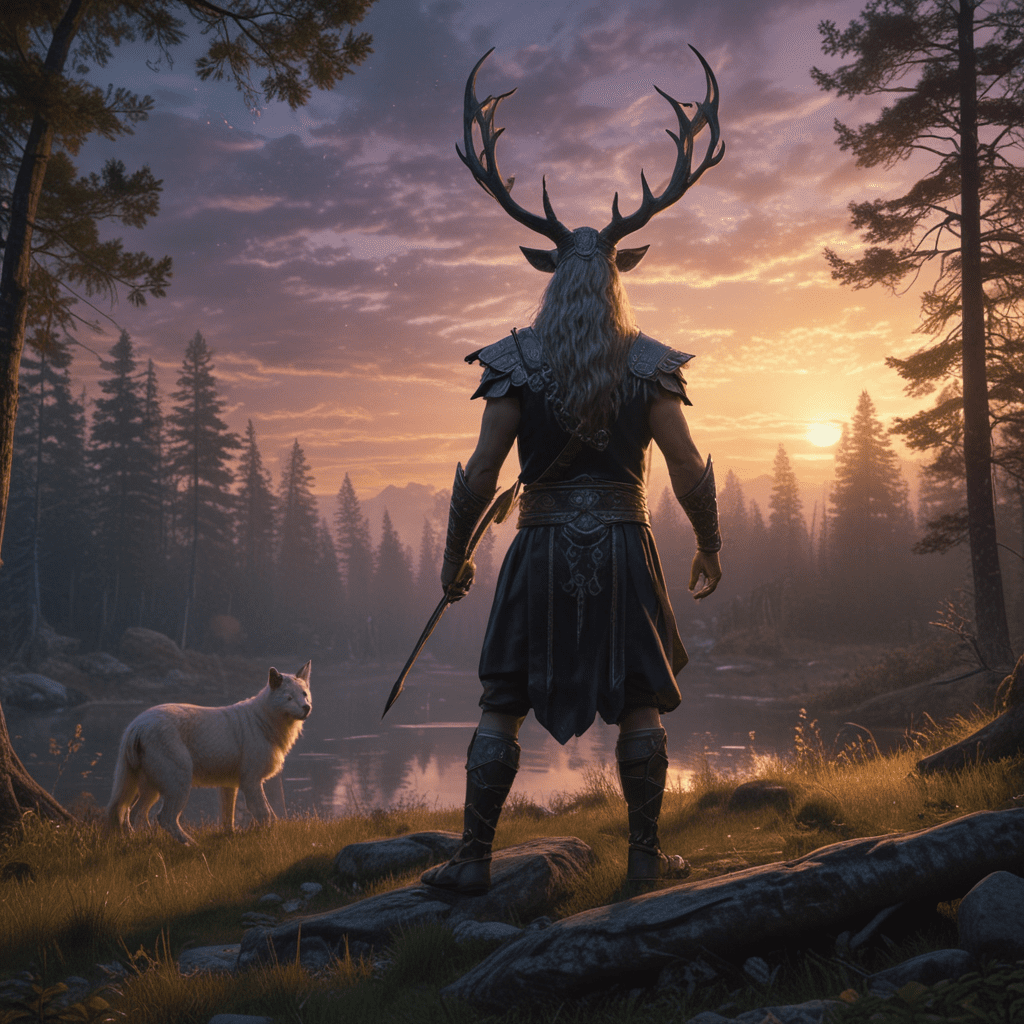Baltic Mythology: Ancestral Spirits and Ancestral Worship
The Baltic region, home to cultures like the Latvians, Lithuanians, and Prussians, has a rich and vibrant mythology deeply rooted in the belief in the power and presence of ancestral spirits. These beliefs, passed down through generations, formed a fundamental part of their worldview and daily life. Their ancestors were not merely figures from the past; they were active participants in the world of the living, influencing everything from the weather and harvest to the well-being of families and communities.
The Ancestral Realm: A Vital Part of Baltic Belief
In Baltic mythology, the world is not simply a physical place but a complex tapestry woven together by the forces of the visible and invisible. The realm of the ancestors, often called "Anavilnis" in Latvian and "Anapilis" in Lithuanian, is a crucial part of this tapestry. This is a spiritual realm where the souls of the departed reside, continuing their existence in a form that exists beyond the physical world. These ancestral spirits act as guardians and intermediaries between the living and the divine, their influence felt in every aspect of life.
The Spirits of the Ancestors: Guardians and Intermediaries
The spirits of the ancestors were not simply disembodied souls. They were imbued with distinct personalities, strengths, and weaknesses, reflecting their lives on Earth. They had the power to protect their descendants from harm, bring good fortune, and offer guidance in times of need. Some spirits were known for their wisdom and could provide insights into the future. Others were associated with specific skills or trades, offering assistance to family members who pursued those lines of work.
The ancestors were also believed to be able to influence the natural world. They could affect the weather, ensure a bountiful harvest, or bring prosperity to their families and communities. This connection to the natural world was deeply intertwined with their role as guardians, ensuring the well-being of their descendants and maintaining the balance of the world.
The Role of Ancestor Worship in Baltic Society
Ancestor worship was not simply a religious practice; it was an integral part of daily life in Baltic societies. It was a way of honoring and respecting the generations that came before, acknowledging their contributions to the present, and ensuring their continued influence on the future.
In essence, ancestor worship provided a sense of continuity and connection across generations. It emphasized the importance of family lineage, the legacy of the past, and the responsibility to honor and respect the sacrifices of ancestors. This deep-rooted belief system helped to shape many aspects of Baltic culture, from social structures to traditions and rituals.
Honoring the Ancestors: Rituals and Offerings
Baltic people honored their ancestors through a variety of rituals and offerings. These practices were designed to appease the spirits, seek their guidance, and ensure their continued protection.
One common practice was leaving food and drink on the graves of deceased ancestors, believing that the spirits could partake in these offerings. These offerings were often accompanied by prayers and songs, expressing gratitude and seeking blessings.
Another important ritual was the "ancestor feast," a communal gathering held in honor of the ancestors. These feasts were often held during specific times of year, such as harvest festivals or the winter solstice. They served as an opportunity to remember the departed, celebrate their lives, and seek their blessings for the coming year.
The Importance of Family Lineage and Ancestral Memory
The concept of family lineage was deeply interwoven with ancestor worship in Baltic culture. The names of ancestors were often passed down through generations, serving as a constant reminder of their legacy. Stories about ancestors were shared among family members, preserving their memories and reinforcing the sense of continuity between generations.
This emphasis on ancestral memory extended beyond the immediate family. Genealogies were carefully documented, tracing family lines back for generations. These records served as a valuable source of information about the past, providing insights into family history, cultural heritage, and the significance of ancestors in the lives of their descendants.
The Relationship Between Ancestral Spirits and the Natural World
The Baltic belief in ancestral spirits was intricately tied to the natural world. The ancestors were seen as custodians of the land and its resources, influencing the weather, fertility, and the well-being of the people. For example, a good harvest was often attributed to the favor of the ancestral spirits, while poor harvests might be seen as a sign of their displeasure.
The natural world was also a place where the ancestors were believed to reside. Certain trees, groves, and sacred sites were considered to be gateways to the ancestral realm. These places held a spiritual significance and were treated with reverence, serving as focal points for rituals and offerings.
The ancestors were often associated with specific elements of nature. For instance, the spirits of warriors might be connected to storms and thunder, while the spirits of farmers might be linked to the growth of crops. This close relationship with the natural world emphasized the interconnectedness of all things and the importance of respecting the balance of nature.
Theories on the Origins of Ancestor Worship in the Baltic Region
There are various theories about the origins of ancestor worship in the Baltic region. Some scholars suggest that it was a widespread practice among early Indo-European cultures, and that the Balts inherited these beliefs from their common ancestors. Others believe that ancestor worship developed independently in the Baltic region, influenced by the specific geographic and cultural circumstances of the area.
One key factor that likely contributed to the importance of ancestors in Baltic mythology was the agricultural lifestyle of the Balts. Their reliance on the land for sustenance made them deeply conscious of the cycles of nature and the importance of ensuring a good harvest. The ancestors were seen as guardians of the land and its fertility, and their influence was crucial in ensuring the prosperity of the community.
Connections to Other Indo-European Mythologies
Baltic ancestor worship shares similarities with similar belief systems found in other Indo-European cultures. In ancient Greek mythology, for example, the concept of the "Manes," or spirits of the dead, plays a significant role in rituals and offerings. The Roman "Lares" and "Penates," household deities thought to be the spirits of ancestors, also demonstrate the widespread presence of ancestor worship across various Indo-European societies.
These shared beliefs suggest that the veneration of ancestors was a fundamental part of the Indo-European worldview, even if the specific practices and beliefs varied across cultures. The Baltic region, with its rich mythology and intricate connection to the natural world, offers a compelling example of how ancestor worship shaped the beliefs and traditions of a specific Indo-European culture.
The Impact of Christianity on Baltic Ancestor Worship
The arrival of Christianity in the Baltic region during the Middle Ages had a profound impact on ancestral beliefs. The Christian church actively discouraged pagan practices, including ancestor worship, which it viewed as incompatible with its own doctrines. Christian missionaries, in an attempt to convert the Baltic people, often portrayed ancestral spirits as demonic entities, seeking to demonize their beliefs and weaken their cultural ties to the past.
Despite the efforts of the Christian church, ancestor worship persisted in many areas, often blending with Christian beliefs and practices. In some cases, ancestral spirits were interpreted as saints or angels, with their protective and guiding roles being acknowledged within the framework of Christian theology. The influence of ancestor worship can still be seen in some Baltic traditions and folklore, even after centuries of Christian influence.
The Enduring Legacy of Ancestral Spirits in Baltic Culture
While the practice of traditional ancestor worship may have declined in the Baltic region, the legacy of these beliefs continues to resonate in contemporary culture. The importance of family lineage, the respect for the past, and the connection to the natural world are still prevalent in Baltic societies. Folklore, songs, and stories continue to feature ancestral spirits, preserving their memory and reminding people of their enduring influence.
Moreover, the influence of ancestral beliefs can be seen in contemporary art, music, and literature. Baltic artists often draw inspiration from the rich tapestry of their mythology, exploring themes of ancestry, the natural world, and the connection between the living and the departed. In a world increasingly focused on the present and the future, the Baltic tradition of ancestor worship serves as a reminder of the importance of honoring the past, honoring our ancestors, and remembering their enduring influence on our lives.
FAQ
Q: What are some of the most common rituals associated with ancestor worship in the Baltic region?
A: Common rituals include leaving food and drink on the graves of ancestors, holding communal feasts in their honor, and maintaining family genealogies as a way of remembering their legacy.
Q: How did the Baltic people perceive the relationship between ancestors and the natural world?
A: The Baltic people believed that ancestors had a strong influence on the natural world, determining the weather, fertility, and overall well-being of the community.
Q: What was the impact of Christianity on Baltic ancestor worship?
A: Christianity discouraged pagan practices, including ancestor worship, but some elements of these beliefs persisted, often blended with Christian elements.
Q: How is the legacy of Baltic ancestor worship still present in contemporary culture?
A: The importance of family lineage, respect for the past, and the connection to the natural world are still prevalent in Baltic societies, reflected in folklore, art, and literature.



